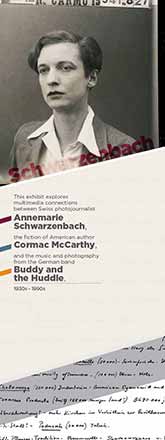Annemarie Schwarzenbach
Annemarie Schwarzenbach,
an enigmatic writer and photojournalist,
was born in 1908 and died young, at age
34, from the consequences of a bicycle
accident. During her short lifetime, she
traveled extensively (including trips to
Persia, Afghanistan, several European
countries, the United States, and Africa), wrote about 300 articles and
photojournalistic essays (some of them under her married name Clark
or Clarac), and took roughly 5,000 photographs.
She was born and raised in a rich Swiss family and throughout her
life caught between this world that enabled her to live a privileged life and
her convictions that stood in stark contrast to her family’s political support
of the far right in Switzerland. She was homosexual, and her friends
included Klaus and Erika Mann, Carson McCullers, Marianne Breslauer,
and Ella Maillart. Throughout her adult life she suffered from an opioid
addiction that she was unable to cut despite several withdrawal efforts.
Her trips to the United States yielded a large array of articles and
photographs that depict the era of the Great Depression. She analyzes
class, and — to a much lesser degree — also race within the context
of the United States. She also looks at the development of unions and
organizations that promote political change that aids the underprivileged.
In her texts she becomes a vivid advocate for groups like the Highlander
Folk School for workers (later Highlander Center) in Monteagle and
shows an interest in alternative lifestyle models, such as the Gruetli
Farm community in Tennessee.
Her depiction of Knoxville in her 1937 essay “On the Shadowy Side
of Knoxville” vividly captures the harsh contrast between privileged
lives and the destitution of those who dwell in extreme poverty in
neighborhoods like what used to be West Front Street. This essay thus
far has not been translated from German to English, and the English
translations provided in this exhibit present for the first time selected
passages to an English-speaking audience.
Annemarie Schwarzenbach
 Annemarie Schwarzenbach,
an enigmatic writer and photojournalist,
was born in 1908 and died young, at age
34, from the consequences of a bicycle
accident. During her short lifetime, she
traveled extensively (including trips to
Persia, Afghanistan, several European
countries, the United States, and Africa), wrote about 300 articles and
photojournalistic essays (some of them under her married name Clark
or Clarac), and took roughly 5,000 photographs.
Annemarie Schwarzenbach,
an enigmatic writer and photojournalist,
was born in 1908 and died young, at age
34, from the consequences of a bicycle
accident. During her short lifetime, she
traveled extensively (including trips to
Persia, Afghanistan, several European
countries, the United States, and Africa), wrote about 300 articles and
photojournalistic essays (some of them under her married name Clark
or Clarac), and took roughly 5,000 photographs.
She was born and raised in a rich Swiss family and throughout her
life caught between this world that enabled her to live a privileged life and
her convictions that stood in stark contrast to her family’s political support
of the far right in Switzerland. She was homosexual, and her friends
included Klaus and Erika Mann, Carson McCullers, Marianne Breslauer,
and Ella Maillart. Throughout her adult life she suffered from an opioid
addiction that she was unable to cut despite several withdrawal efforts.
Her trips to the United States yielded a large array of articles and
photographs that depict the era of the Great Depression. She analyzes
class, and — to a much lesser degree — also race within the context
of the United States. She also looks at the development of unions and
organizations that promote political change that aids the underprivileged.
In her texts she becomes a vivid advocate for groups like the Highlander
Folk School for workers (later Highlander Center) in Monteagle and
shows an interest in alternative lifestyle models, such as the Gruetli
Farm community in Tennessee.
Her depiction of Knoxville in her 1937 essay “On the Shadowy Side
of Knoxville” vividly captures the harsh contrast between privileged
lives and the destitution of those who dwell in extreme poverty in
neighborhoods like what used to be West Front Street. This essay thus
far has not been translated from German to English, and the English
translations provided in this exhibit present for the first time selected
passages to an English-speaking audience.


...the journey seems to me less an adventure and a foray into unusual realms than a concentrated likeness of our existence: residents of a city, citizens of country, beholden to a class or a social circle...
— Annemarie Schwarzenbach —